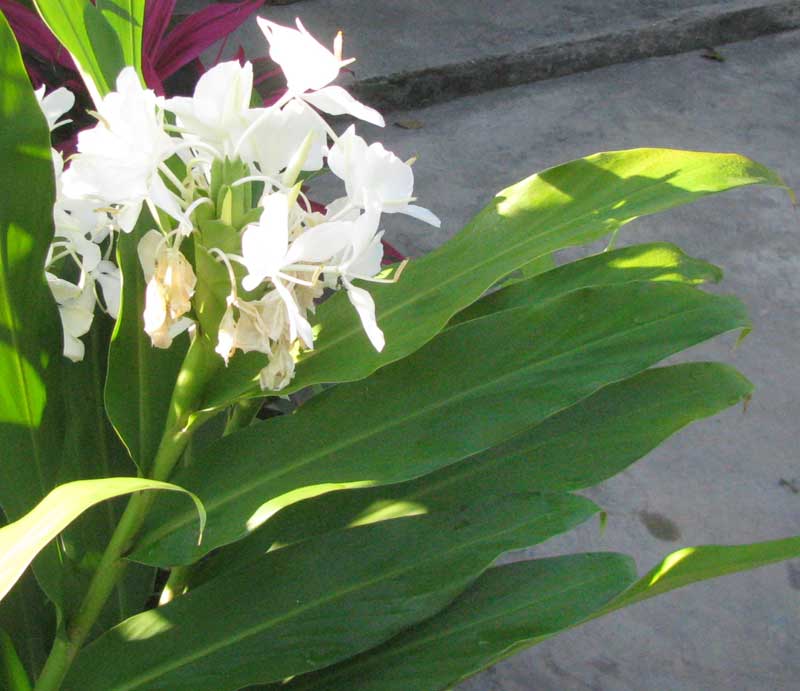Excerpts from Jim Conrad's
Naturalist Newsletter

from the January 15, 2012 Newsletter issued from Hacienda Chichen Resort beside Chichén Itzá Ruins; limestone bedrock; elevation ~39m (~128ft), N20.675°, W88.569°; central Yucatán state, MÉXICO
GINGER LILY
Around most homes in backstreet Pisté there's an impressive diversity of ornamental plants, but mostly it's the same species again and again. However, in one family's tiny front yard, right beside their stone wall along the road, nowadays there are two famous garden ornamentals I've not seen elsewhere in town. They're closely related species and planted beside one another, and both are so robust that each day they must be watered together. I'll bet someone bought them at the same time, set them close together, and now their intermingling stems produce a gorgeous, hippopotamus-size display. One species is shown above.
That's the Ginger Lily, sometimes also called Garland-Flower, Butterfly-Lily, Butterfly-Ginger and other names. It's HEDYCHIUM CORONARIUM, originally from the Himalayan region of Nepal and India but now grown in the tropics worldwide. In Cuba it's so admired that it's the national flower. Not only is it very pretty, but also dizzyingly fragrant. In the past its flowers were favored adornments for ladies.
The flowers have a peculiar construction, as shown below:

In that picture the calyx is hidden within a curved bract in the lower, left corner. The corolla does have clearly visible petals, but they're much narrower than the broad, flaring items that look like white petals, but which in fact are staminodes. Staminodes are modified stamens.
Along the picture's right margin the upwardly bent item is very unusual. Atop the near-vertical, banana-shaped part you see a green, globular thing. That's the stigma, which means that the "ovary neck," or style, is enclosed within the banana-shaped structure. The banana-structure is the single anther -- the baglike thing in which pollen is produced -- of the flower's single fertile stamen. The anther consists of two cells, and here the style is clasped between them.
So, one wonders why this flower evolved so that its stamens ended up doing the job that corolla petals usually do, even though it had perfectly good petals to work with. Also one wonders why most flowers seem to think they need five or more stamens, but this one decided to get along with just one.
Whatever the case, Ginger Lilies are one of the tropical world's most precious ornamental species. Besides their beauty, another reason they are grown so frequently is that they survive just about any frostless place where there's plenty of sunlight and water. In fact, in many countries with cool, rainy habitats similar to their native Himalayan-foothills they've escaped into the wild, becoming "weeds."
Despite being in the Ginger Family, apparently the roots aren't used like garden Ginger. However, the flowers and young buds can be eaten and used as flavoring. The roots also can be cooked and eaten, though they're not flavorful or nourishing enough to be considered anything other than a famine food.